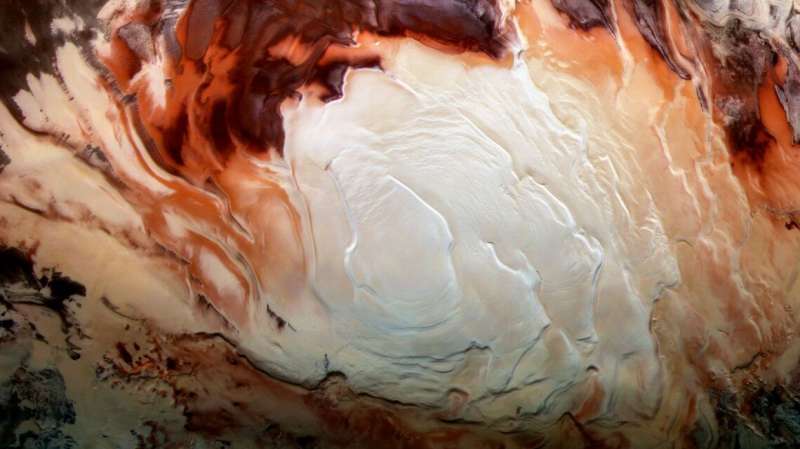Mars' bright south pole reflections may be clay—not water

Bright reflections observed at Mars' south pole serve as evidence for water. But, seeing may be deceiving.
After measuring the area's electrical properties with orbiting, ground-penetrating radar, an international group of scientists now say that reflections of the red planet's south pole may be smectite, a form of hydrated clay, buried about a mile below the surface, according to a July 29 report in the journal Geophysical Research Letters.
The research, led by Isaac B. Smith of York University, Toronto, with major contributions by second author Dan Lalich, research associate in the Cornell Center for Astrophysics and Planetary Science in the College of Arts and Sciences, said the presence of liquid water requires implausible amounts of heat and salt.
"Those bright reflections have been big news over the last few years because they were initially interpreted as liquid water below the ice," Lalich said. "That interpretation is inconsistent with other observations that imply the ice isn't warm enough to melt, given what we know about conditions on Mars."
Even on Earth, Lalich said, it is rare to see subsurface reflections from radar that are brighter than the surface reflection.
The reflection is about a mile below the planet's surface, where "you don't expect as bright of a reflection," he said. "We were getting radar reflections that were much brighter than the surface. And that's really weird. It's not something that we had really seen before and it's not something we expected."
The group had pored over data from the MARSIS (Mars Advanced Radar for Subsurface and Ionosphere Sounding) instrument—a radar that examines the Martian subsurface with a 130-foot antenna via the European Space Agency's Mars Express orbiter. The MARSIS instrument, jointly developed by the Italian Space Agency and NASA's Jet Propulsion Laboratory, can probe the planet to a depth of three miles.
Lalich and the other scientists used a diagnostic physical property in ground-penetrating radar called dielectric permittivity, which measures the ability to store electric energy. The group used the reflection strength to estimate the permittivity difference between the ice and the base of the polar cap, and then compared that estimate to lab measurements of smectite.
"Smectites are very abundant on Mars, covering about half the planet, especially in the Southern Hemisphere," said York University's Smith. "That knowledge, along with the radar properties of smectites at cryogenic temperatures, points to them being the most likely explanation to the riddle."
Lalich said the data to confirm the hydrated clay was easily reproduced from the observed data, meaning that liquid water is not necessary to generate bright reflections. The scientists were hoping to find lakes and other geologic forms.
"Unfortunately, that's a bit of a downer," he said, "because lakes below the ice cap would have been very exciting. We believe the smectite hypothesis is more likely and it's more consistent with other observations."
In addition to Smith and Lalich, the co-authors on "A Solid Interpretation of Bright Radar Reflectors Under the Mars South Polar Ice," are Craig Rezza, graduate student, York University; Briony Horgan, associate professor, Purdue University; Jennifer L. Whitten, assistant professor, Tulane University; and Stefano Nerozzi, postdoctoral research associate and Jack Holt, professor, University of Arizona.
More information: I. B. Smith et al, A Solid Interpretation of Bright Radar Reflectors Under the Mars South Polar Ice, Geophysical Research Letters (2021). DOI: 10.1029/2021GL093618
Journal information: Geophysical Research Letters
Provided by Cornell University





















